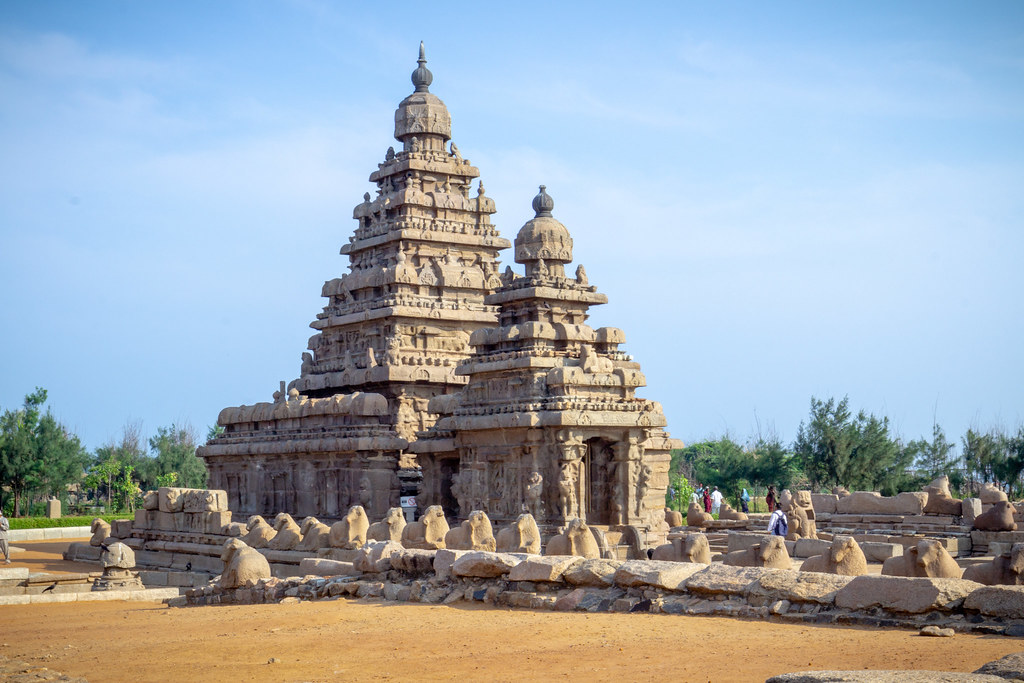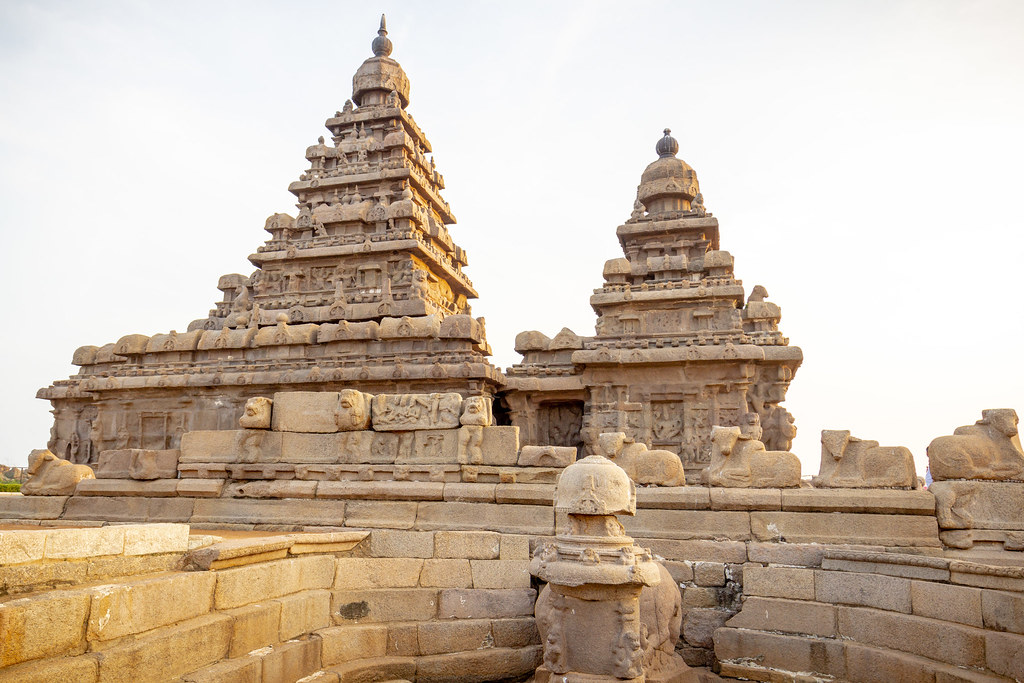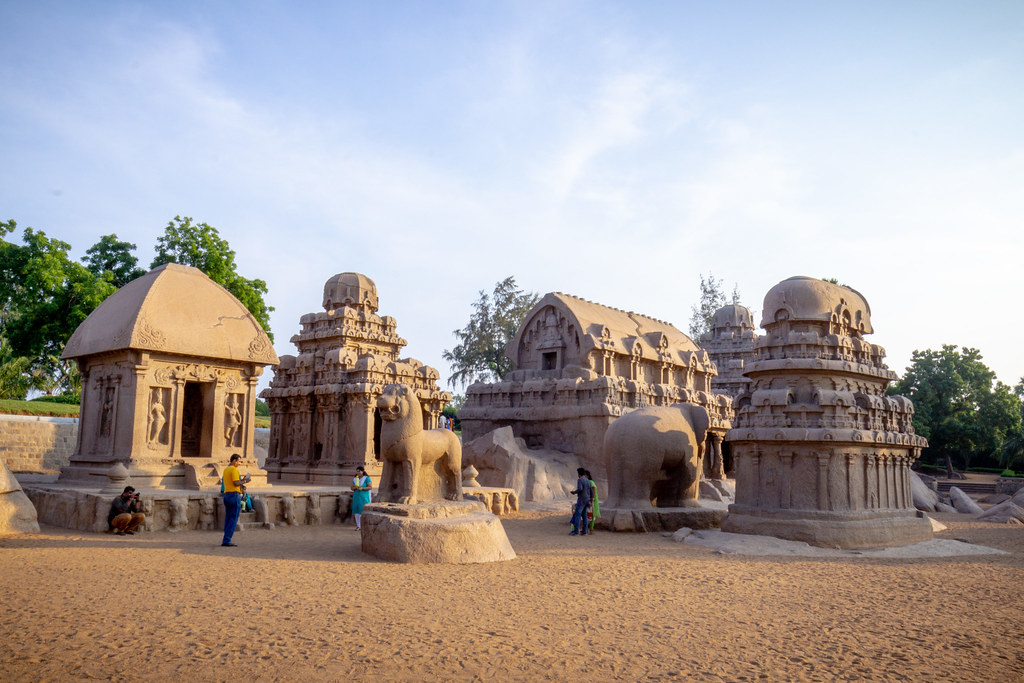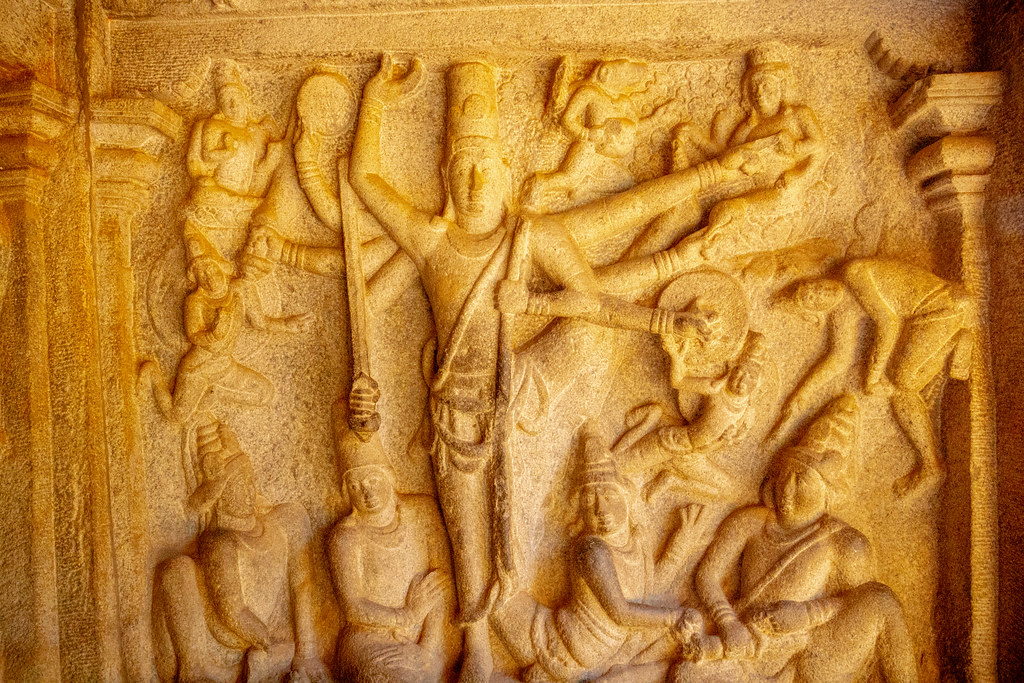Mahabalipuram or Mamallapuram is a historic city and UNESCO World Heritage site in Tamil Nadu, India. During the reign of the Pallava dynasty, between the 3rd century CE and 7th century CE, it became an important centre of art, architecture and literature. Mahabalipuram was already a thriving sea port on the Bay of Bengal before this time. A significant amount of coins and other artefacts excavated from this region also indicate a pre-existing trade relation with the Romans even before it became a part of the Pallava Empire.
The site has 400 ancient monuments and Hindu temples, including one of the largest open-air rock reliefs in the world: the Descent of the Ganges or Arjuna’s Penance.
The group contains several categories of monuments: ratha temples with monolithic processional chariots, built between 630 and 668; mandapa viharas (cave temples) with narratives from the Mahabharata and Shaivic, Shakti and Vaishna inscriptions in a number of Indian languages and scripts; rock reliefs (particularly bas-reliefs); stone-cut temples built between 695 and 722, and archaeological excavations dated to the 6th century and earlier.
The monuments were built during the Pallava dynasty. Known as the Seven Pagodas in many colonial-era publications, they are also called the Mamallapuram temples or Mahabalipuram temples in contemporary literature. The site, restored after 1960, has been managed by the Archaeological Survey of India.
- Ratha temples
- Dharmaraja Ratha
- Bhima Ratha
- Arjuna and Draupadi Rathas
- Nakula Sahadeva Ratha
- Other rathas
- Cave temples
- Varaha
- Kotikal
- Dharmaraja
- Ramanuja
- Koneri
- Krishna
- Atiranachanda
- Adivaraha
- Mahishasuramardini
- Panchapandava mandapam
- Other mandapas
- Structural temples
- Shore Temple
- Olakkanesvara temple
- Mukundanayanar temple
- Rock reliefs
EARLY HISTORY
Mahabalipuram’s early history is completely shrouded in mystery. Ancient mariners considered this place the land of the Seven Pagodas. There are others who think that Mahabalipuram suffered from a great flood between 10,000 and 13,000 BCE.
Many opinions exist about the origin of the name of the site too. The most popular explanation is that the place is named after benevolent King Bali, also known as Mahabali. The ancient Indian text of Vishnu Puran documents his exploits. After sacrificing himself to Vaman, an incarnation of Vishnu, he attained liberation. “Puram” is a Sanskrit term for a city or urban dwelling. Mamallapuram is the Prakrit version of the original Sanskrit name.
 Although the ancient history of Mahabalipuram is unclear, numismatic and epigraphical evidence and its temples suggest that it was a significant location before the monuments were built. It is speculated that it is the seaport of Sopatma mentioned in the 1st-century periplus of the Erythraean Sea or Ptolemy’s port of Melange in his 2nd-century Geographia. Another theory posits that the port of Nirppeyarvu mentioned in the Perumpanarrupadai from the early centuries of the common era may be Mahabalipuram or Kanchipuram.
Although the ancient history of Mahabalipuram is unclear, numismatic and epigraphical evidence and its temples suggest that it was a significant location before the monuments were built. It is speculated that it is the seaport of Sopatma mentioned in the 1st-century periplus of the Erythraean Sea or Ptolemy’s port of Melange in his 2nd-century Geographia. Another theory posits that the port of Nirppeyarvu mentioned in the Perumpanarrupadai from the early centuries of the common era may be Mahabalipuram or Kanchipuram.
In his Avantisundari Katha, the Sanskrit scholar Daṇḍin (who lived in Tamil Nadu and was associated with the Pallava court) praised artists for their repair of a Vishnu sculpture at Mamallapuram. However, Daṇḍin’s authorship of this text is disputed. The medieval Sanskrit text mentions the Mamallapuram monuments, an early tradition of repairs, and the significance of Vaishnavism.
When Marco Polo arrived in India on his way back to Venice from Southeast Asia, he mentioned (but did not visit) “Seven Pagodas” and the name became associated with the shore temples of Mahabalipuram in publications by European merchants centuries later. It appeared in Abraham Cresques’ 1375 Catalan Atlas as “Setemelti” and “Santhome”, a crude map of Asia but accurate in the relative positions of the two ports; the former is Mamallapuram and the latter Mylapore. Venetian traveler Gasparo Balbi mentioned the “Seven Pagodas” and “Eight Pleasant Hillocks” in 1582, which Nagaswamy suggests refers to the monuments. According to Schalk, Balbi called it the “Seven Pagodas of China” (a re-interpretation of Henry Yule’s reading of Balbi which considered Balbi unreliable, followed by a selective correction that it probably meant Mamallapuram)
Since there are now fewer than seven towers, the name has inspired speculation and argument. The December 2004 tsunami briefly exposed the beachfront near Saluvankuppam (now north of Mahabalipuram), revealing inscriptions and structures. Badrinarayanan said in a BBC report that they dated to the 9th century and may have been destroyed by a 13th-century tsunami. The tsunami also revealed large structures on the seabed about a kilometer offshore, which archaeologists speculate may be the ancient Mahabalipuram. According to a Science article, the tsunami exposed rocks with an “elaborately sculpted head of an elephant and a horse in flight”, “a small niche with a statue of a deity; another rock with a reclining lion”, and other Hindu religious iconography. Marine archaeologists and underwater diving teams have explored a site east of the Shore Temple, one of the monuments, after the 2004 tsunami. This has revealed ruins of fallen walls, a large number of rectangular blocks and other structures parallel to the shore, and the forty surviving monuments.
Modern reports
European sailors and merchants who pioneered trade with Asia after the 16th century mentioned the site. Early reports, such as those by Niccolao Manucci (who never visited the site, but saw the monuments from a distance and heard about them) conflated Chinese and Burmese Buddhist pagoda designs with the Hindu temples and assumed that the temples were built by the Chinese. According to Anthony Hamilton’s 1727 account of the “East Indies”, the site was a pilgrimage center and its outside sculpture was “obscene, lewd” as a performance in Drury Lane. French writer Pierre Sonnerat was critical of European racism toward Indians, and theorized that the Mahabalipuram temples were very old.
William Chambers’ 1788 literary survey of Mahabalipuram brought the monuments to the attention of European scholars. Chambers interviewed local residents and linked the monumental art he saw to Hindu texts, calling it remarkable and expressive in narrative detail. A series of 19th-century studies, such as those by Benjamin Babington and William Elliot, contained sketches of the monuments and impressions of the inscriptions. Some stories and speculation in Western literature, nevertheless, continued to be unusual. Francis Wilford suggested in 1809 that the monuments were built in 450 BCE, linking them to Cicero’s writings about Indians who might have built three ancient Indian temple cities (including Mahabalipuram).
Nineteenth-century reports note local mentions of “gilt tops of many pagodas” in the surf at sunrise, which elders talked about but could no longer be seen. In the late 19th and early 20th centuries, the Mahabalipuram site was the focus of colonial-era tourist guides and speculation. Portions of many monuments were covered with sand, and little was done to preserve the site. After Indian independence, the Tamil Nadu government developed the Mamallapuram monuments and coastal region as an archaeological, tourism and pilgrimage site by improving the road network and town infrastructure. In 1984, the site was declared a UNESCO World Heritage Site.
The group has been the subject of archaeological interest since 1990, and excavations have yielded unexpected discoveries. According to John Marr, the site yielded “an apsidal-shaped tank, its curved end aligned south towards the middle portion of the Shore Temple” with an
Pallava construction
Mamallapuram became prominent during the Pallava-era reign of Simhavishnu during the late 6th century, a period of political competition with the Pandyas, the Cheras and the Cholas and spiritual ferment with the rise of 6th- to 8th-century Bhakti movement poet-scholars: the Vaishnava Alvars and the Shaiva Nayanars. Mamallapuram’s architecture is linked to Simhavishnu’s son, Mahendravarman I (600-630 CE), who was a patron of the arts. Mahendravarman’s son, Narsimha Varman I, built on his father’s efforts and most scholars attribute many of the monuments to him. After a brief hiatus, temple and monument construction continued during the reign of Rajasimha (or Narasimhavarman II; 690-728).
Mid-20th-century archaeologist A. H. Longhurst described Pallava architecture, including those found at Mahabalipuram, into four chronological styles: Mahendra (610-640), Mamalla (640-670, under Narsimha Varman I), Rajasimha (674-800) and Nandivarman (800-900). K. R. Srinivasan described it as reflecting three styles and stages of construction, calling the third period the Paramesvara style.
This chronology has been the subject of scholarly disagreement. Some scholars, such as Marilyn Hirsh in 1987, have said that the earliest temples are traceable to about 600 (under the poet-king Mahendravarman I). Other, such as Nagaswamy in 1962, have said that King Rajasimha (690-728) was the probable patron of many monuments; many temple inscriptions contain one of his names and his distinctive Grantha and ornate Nāgarī scripts.
Evidence dating some of the Mamallapuram monuments to the early 7th century includes the Mandagapattu inscription (Laksitayana inscription) of Mahendravarman I. The inscription reads that he “brought into existence a temple without utilizing either timber or lime (mortar) or brick or metal”, and the temple was dedicated to “Brahma, Vishnu and Shiva”.
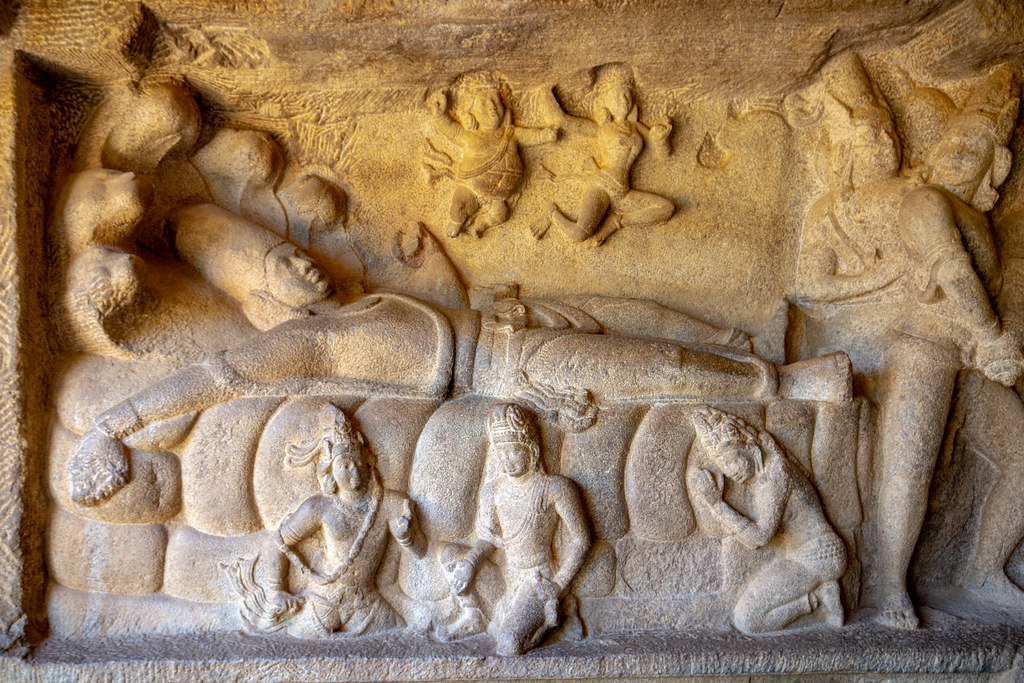 This was the first Pallava rock-built Hindu temple, and Mahendravarman I and his descendants probably constructed others. According to Mate and other scholars, the inscription implies that the Tamil people had a temple-construction tradition based on the mentioned materials which predated the 6th century.
This was the first Pallava rock-built Hindu temple, and Mahendravarman I and his descendants probably constructed others. According to Mate and other scholars, the inscription implies that the Tamil people had a temple-construction tradition based on the mentioned materials which predated the 6th century.
The Mandagapattu inscription is not isolated, and additional Mahendravarman I inscriptions relating to cave temples have been discovered across his kingdom. Further evidence is in the form of cave temples (such as the Undavalli Caves) which predate the Mamallapuram cave temples, suggesting that Indian artisans began exploring cave architecture before the Pallava period. The monuments at Mamallapuram are generally dated by scholars to the 7th and 8th centuries
